#which is pretty much how i imagine fafnir’s voice to sound like
Explore tagged Tumblr posts
Text
i was agonising over who i’d cast as fafnir’s english voice actor and then the answer came to me in a dream: shohreh aghdashloo.
#sev.screams#sev.archive#archive: fafnir#she voiced grayson in arcane btw#which is pretty much how i imagine fafnir’s voice to sound like#breathing fire would do a number on your throat#so sounding like she smokes 4 packs a day makes sense#i love it when i fucking COOK
7 notes
·
View notes
Text
Kobayashi’s Maid Dragon Episode 5 Notes

Miso soup has extremely strong associations with home and family in Japan. It’s a staple of breakfast and dinner tables, especially when paired with rice (which is common, to say the least), and is a very traditional dish with a long history.
It’s such a big deal, even, that the question “I want to eat the miso soup you make every day,” is a stereotypically Japanese marriage proposal.
When I say “stereotypically Japanese,” I mean that Japanese people see it that way. The Japanese language and culture tend to be pretty “indirect” compared to others (particularly English, which everyone in Japan spends years in school studying), and people in Japan are very aware of this. A common example given in schools is the famous translation by Natsume Souseki, where he translated the phrase “I love you” in an English text to “The moon is beautiful, isn’t it?” in Japanese.
Anyway there’s some context for this scene, and in particular the choice of miso soup as the dish Kobayashi commented on.

You’ll notice they have at least four umbrellas there. It’s easy for those cheap vinyl ones to pile up when you have to do a bunch of walking (even just to/from the train station); you can’t just keep one in the car, and if it starts raining on a day you didn’t bring one...
By the way, in case you were thinking “four for three people isn’t that many though,” she had a different four in episode one, even before Tohru showed up:

Also: man, that before&after. Good for you Kobayashi ;_;

She says “aitsura あいつら” here, meaning they not she; basically Kanna, at least, is being included here.
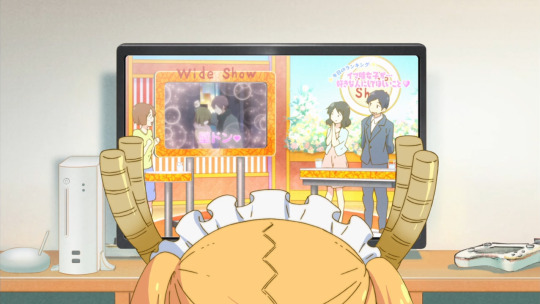
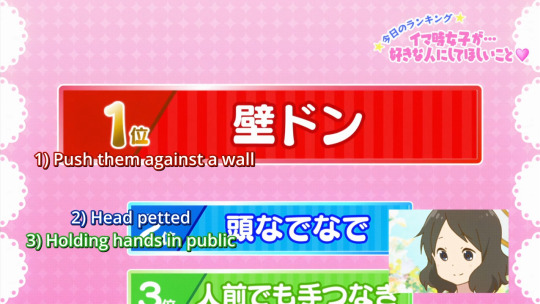

These shows totally exist, they look exactly like this, and they literally have done this topic. In fact, this specific topic is a common one, with the list being updated every so often. “Wide show” is actually the name of this type of show, a subset of the infamous “variety show.”
Number one is “Kabe-don” (kabe = wall, and don = sound effect for like “slam/bang”). Originally the word was (and still is) used to refer to when people in the next room over would bang on the wall to politely inform you that you’re being too fucking loud it’s after midnight already god damn.
In the past few years though, the word caught on as a meme, referring to a common situation that pops up in shoujo manga a lot, where the(/a) love interest would do this:

to the heroine. This specific usage of the term was seemingly coined by voice actress Shintani Ryoko (Sae from Hidamari Sketch) in 2008, while she was trying to explain the act on a radio show when discussion “moe situations”.
Kabe-don’s popularity seems to have died down some lately though (since honestly it’s pretty awkward irl).
The others are pretty self-explanatory I think, though it’s perhaps worth pointing out that yes, these are all things you actually can find on these lists. If “holding hands in public” sounds way too normal/basic to be on one to you, well, welcome to Japan.
(To be fair it’s not like super rare or anything, just not as common as you’d expect in many other countries and kind of considered a little embarrassing, particularly for men.)
Another semi-recently popular one of these “moe whatevers” is ago-kui 顎クイ, basically “chin tug/pull”, where the kui-er grabs the kui-ee’s chin to pull their face closer or whatever (often as a precursor to a kiss, for example). It’s a common pair with the kabe-don.
Basically the takeaway here is that Japan’s been making memes real since way before 2016 came along.
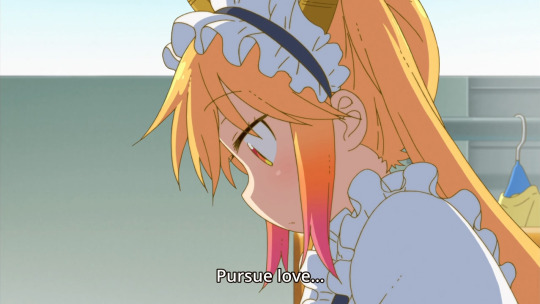

The word for “pursue love” here is kyuuai 求愛, which is probably most commonly used when referring to the mating calls/rituals of animals (as seen by how Tohru likens the audience/panel squeals to bird cries). You can use it with people too, but it’s not exactly very conversational language.

Lol.
Also yeah “Tatsumi 辰巳” has that dragon zodiac kanji in it again. By the by, while there’s no Tatsumi-cho in Tokyo, there is just a “Tatsumi.” It’s by Tokyo Bay, within walking distance of Comiket-host Big Sight and the life-sized Gundam statue, and roughly where a lot of March Comes in Like a Lion is set.
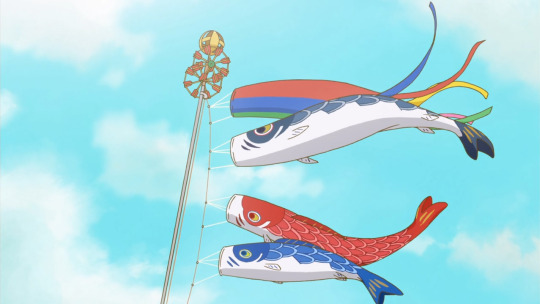
These fish flags/wind socks (they’re koi, trying to climb the waterfall and become dragons, i.e. Magikarp) are traditionally put up on Children’s Day, May fifth. Yet another way Kyoani uses these establishing shots to tell you what season it is and invoke certain associations.

You’ll see this “48 ___ skills/techniques” thing a fair bit in Japanese media; it’s a reference to the 48 Killer Techniques of Kinnikuman/Ultimate Muscle (I think that’s as far back as the reference goes, anyway).
Yes, the name of the store in the background has one of the dragon kanji in it’s name (the lower portion of 籠, 龍).
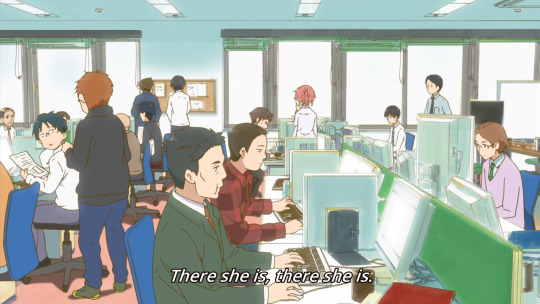
Yeah this is what most Japanese office workplaces look like; open office plans. It’s kind of stressful having no privacy like that, but it does make it easier to ask people stuff I guess.

The “proper” version of this word is sumimasen すみません, basically meaning sorry/excuse me. What he says is saasen サーセン, a rather colloquial version of it. It kind of goes like: sumimasen → suimasen → sunmasen → saasen.
This sort of thing is quite common in Japanese, especially when there’s a set way you’re supposed to say something (as is common) that has a lot of syllables. Another example you might hear is arigatou gozaimashita being shortened down to azashita, typically at a convenience store or something, from an employee who’s busy with something else and just saying it because they have to.

What he says here is shou ga nai しょうがない. If you’ve ever picked up on how often “can’t be helped” or similar seems to be said in anime...this is what that is. It’s an incredibly common phrase in Japan, not just in anime but irl as well. It literally means that there’s nothing that can be done, and can be used in a broad swath of situations. It’s actually fairly similar to “oh well” in a number of cases.
Like above, it has several variations depending on how formal/informal you want it: shikata arimasen, shiyou ga nai, shou ga nai, shaanai, etc. etc.

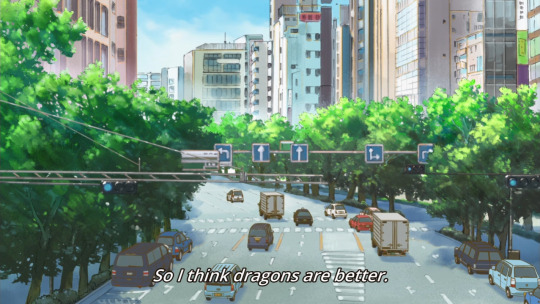
Very minor nuance point, but she says she thinks dragons are superior (~��上, are “above”). “I think dragons are better” sounds, to me, more like indicating preference (”I like dragons better”), whereas the Japanese line has more of an observational tint to it (”Dragons appear to be superior”).
Again, minor and arguable point, but if I didn’t like to be pedantic I wouldn’t be writing these things.

Similar situation as the above, but I would say this is referring specifically to Kobayashi; more “she hasn’t noticed, has she?” than “no one.”
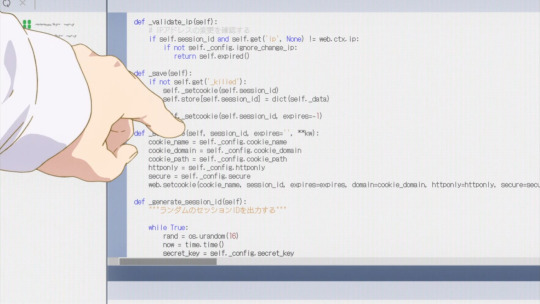
This is actual code, you can find it in places like here.

I like how the lint roller seems to have pink hair on it.
Also, just to restate, this is totally a Japanese everyworkplace and it is kind of giving me flashbacks.
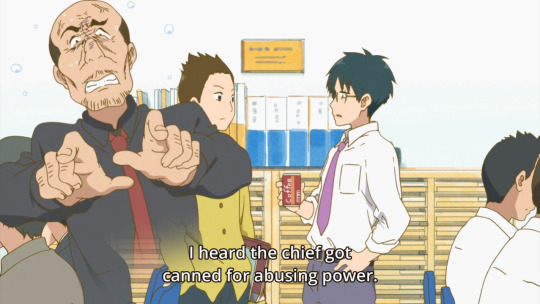
The word for “abusing power” here is pawahara パワハラ, short for power harassment, another Japanese English-ism. It’s often paired with sexual harassment (sekuhara セクハラ) when discussing abuse in the workplace, and both are illegal. A common and particularly serious example of it is forcing people to work unpaid overtime at the threat of being fired.
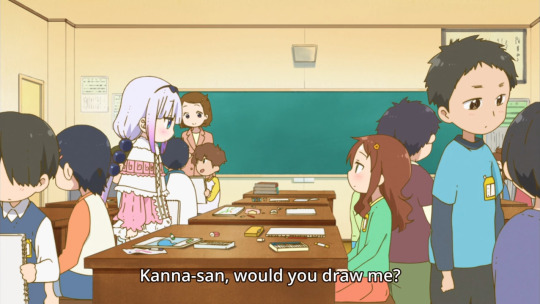
Another nuance thing, but Saikawa here is not so much asking Kanna to draw her, but more expressing surprise, like “Wait you’re willing to draw me?”
Saikawa (才川)’s name, by the way, sounds like “the cutest” (最カワ). If you’ve heard of the Saimoe contests, it sounds like that but the kawa from kawaii instead of moe, a common sort of abbreviation.

Hmmm, I wonder what this could mean...

Ah.

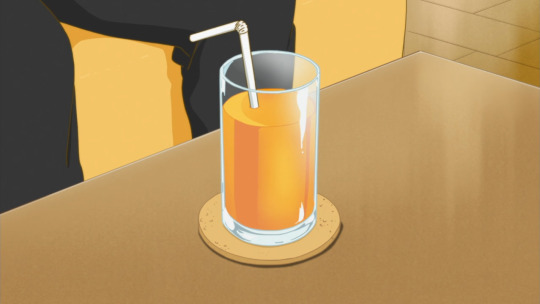
You’re supposed to offer a drink to visitors in Japan, both to your home or to your office (like people from another company there for a meeting). I imagine that’s not exactly unique to Japan by any stretch, but as a custom it’s given more weight than in many others. A question of degree, I guess.
I’m sure there’s some reasoning behind the change in drinks from hot tea to orange-whatever, but who knows what. My guess is that it’s (possibly among other things) another way to show that the seasons are changing; it was cold the first time he came, so a hot drink, and warmer the second, so a cold drink. (Not to say there was a long time skip between the two necessarily, but of course the weather can change on a dime in spring, chilly one day and surprisingly hot the next.)
The way he phrases this, o-tenami haiken to ikou ka お手並み拝見と行こうか。is some pretty fancy language. Nothing much to say about it specifically that the translation doesn’t convey, but just a general note that Fafnir regularly uses less conversational language than the rest of the cast (as you might expect from his demeanor) in ways the subs don’t necessarily make clear.
As an inverse example, this line from earlier:

“Shall we go home?” sounds sorta fancy, but the Japanese line, just “kaerokka 帰ろっか,” is casual as fuck.
This is one of those things that can be difficult when translating Japanese to English, as Japanese has many different ways of saying literally just the same word but with different levels of formality, where in English you have to come up with different ways to phrase it to try and capture both the meaning and the formality level. Possible, but often time-consuming.
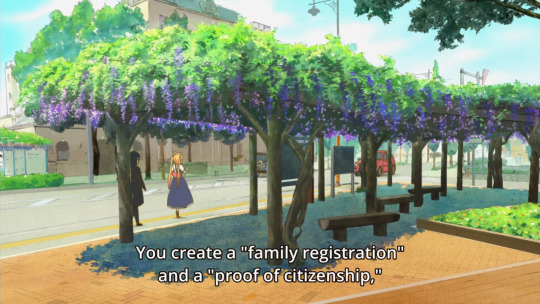

A family registration, koseki 戸籍, refers to document proving, basically, your family tree. When the government, way back when, was deciding how to administer the population, they figured it would be easier to group people into family units and have the family choose a head of household that would both represent them and have responsibility for them.
So they created this family registry system, where everyone* is registered as a member of a family. The “head of household” thing isn’t so important anymore, but the registry still fulfils the role of birth/death certificates, keeps track of marriages/divorces/adoptions, is proof of citizenship, and is effectively a constantly-updated census.
There can only be one family name per koseki, so it’s impossible to get married and not change your last name (unless you happen to have the same last name already); one of the two must join the other’s koseki and take on that name.
*Everyone, who is a citizen that is. Foreigners who marry a Japanese citizen are listed on the registry, but are not officially part of it.
Note that you usually don’t actually need this necessarily to rent an apartment irl. Usually a juumin-hyou 住民票 covers it.
“But wait,” you ask, “why does it say proof of citizenship in the sub when she says juumin-hyou, if the koseki is the proof of citizenship and the family registration?” as I put several words in your confused and increasingly angry mouth.
Well, probably because either the translator wasn’t familiar with these minor details and isn’t paid enough to look them up, or they felt that would make more sense to the average viewer.
A juumin-hyou 住民票 is actually a certificate of residency. It keeps track of your address and various other personal details (immediate family, social security number equivalent, birthdate, etc.). This one foreigners can get, assuming they have a proper visa, and is the one you’ll need to do most things like opening a bank account or signing a lease agreement.
Note that this thing means you’re required to fill out paperwork at city hall whenever you move, so they can keep it updated with your correct address.
A “personal seal” is a little stamp with your name, which is used like a signature would be in many other countries (i.e., for signing contracts and such). Make sure it doesn’t get stolen!
Often, people will have three of these that each have different levels of authority. The “real” one (jitsu-in 実印), for contract signing, must be registered with the government so they can prove it’s really yours. The “bank” one (ginkou-in 銀行印), registered with the bank upon opening a bank account (can be the same as the jitsu-in if you want it to be). And the “Amazon delivery” one (mitome-in or nin-in 認印), which isn’t registered officially anywhere, and is probably most often used nowadays when “signing” for a package delivery.
Of course, Tohru just magicked all of these into existence, because she can do that. Augh.
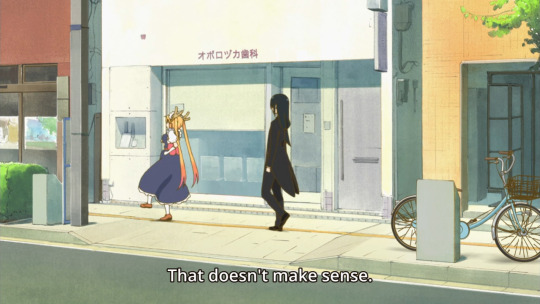
I know Fafnir. I know.
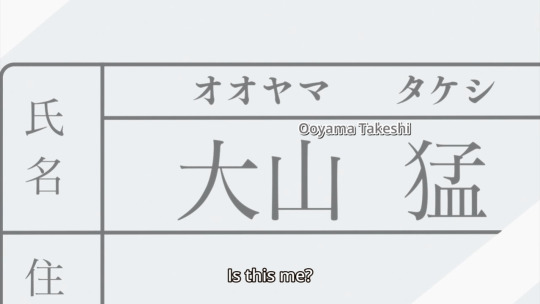

The kanji for Ooyama (大山) mean “big mountain,” and the kanji for Takeshi (猛) means basically “ferocious.”
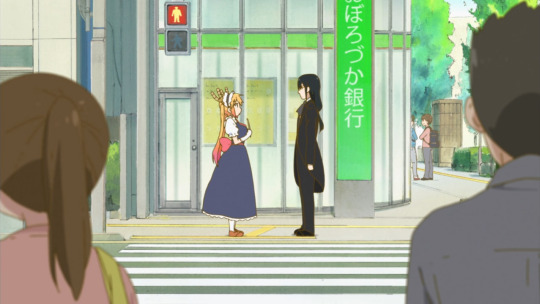
The building in the background here is a bank!

The building in the background here is a business that dispatches staff to support elderly people who can’t fully live on their own!

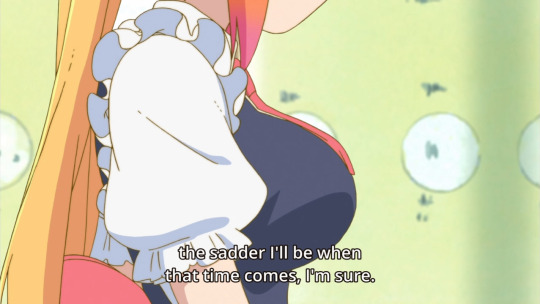
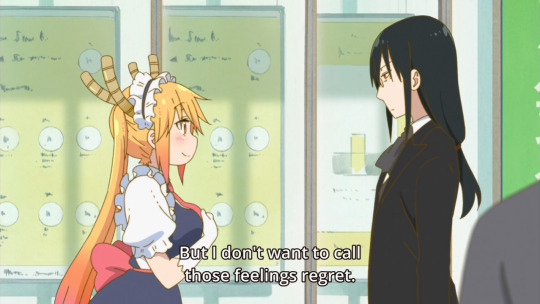
Another fairly minor point, but here she’s saying “I don’t think I’d call those feelings ‘regret’.” not “I don’t want to [...].” (だけど私はその気持ちを後悔とは呼ばないと思います). Not a big difference, but possibly an important one depending on how deeply you care to read into things.
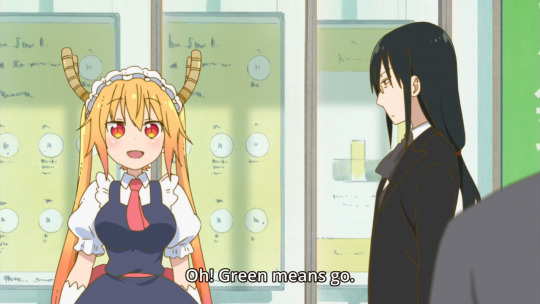
The word here for “green,” ao 青, usually means “blue.” And in fact sometimes the “green” traffic lights in Japan actually are blue. However, up until relatively recently, the “ao” color word actually covered both blue and green (now midori 緑 is the usual word for “green”). This relative lack of distinction between blue and green is actually common in many languages.
As a random anecdote, a Japanese acquaintance of mine who was living in America once got pulled over for running a red light. Though their English was very good, they still got mixed up and kept trying to tell the police officer “I’m sorry I thought the light was blue,” which made for a very awkward talk.
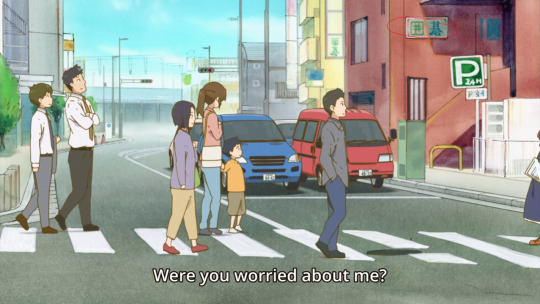
This sign means Go. The game, not the verb. You know, this one.


The kanji for “money” (kane 金) is also the kanji for gold (usually “kin”).

Tadpole is another spring season word.
Probably unrelated, but one Japanese variant of the saying “like father like son” is “the child of a frog is a frog.”

The word for “psychic powers” (such as ESP) in Japanese is basically “super abilities.”

And the word for “magic trick” (at least, the one used here) is tenjina 手品, more like “hand trick” (in a literal sense, anyway). Magic trick is a perfectly good translation, but since they were just talking about how it wasn’t magic and clearly don’t know what a “magic trick” is, I just wanted to give some context as to why that line sounds less off(?) in the Japanese.
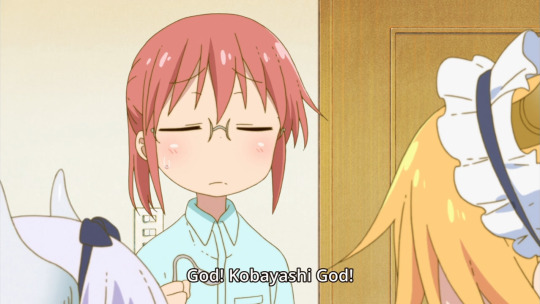
Like in the last episode with cute/kawaii, Kanna says “kami” the first time and “god (goddo)” the second. You...probably noticed that, but yeah.

"To enter [into] your hand” (te ni ireru/hairu 手に入れる/入る) is an idiom that means to get/gain/obtain. Like in a Zelda game or something when you open a treasure chest and get an item, this is the phrase used. Or when someone is elected to a high office, they’ve “te ni ireru’d” themselves some political power.
It’s a super common phrase, such that...and I hesitate to say this...I actually don’t think it was an intended pun(!). As in, I don’t think a native speaker would recognize that it was supposed to be one, even if it was intentional. It’s the kind of joke that’d be so painful you’d have a bunch of people gnashing their teeth about it online, and I haven’t been able to find any of that.

The word here is detarame でたらめ, which is closer to something like bunk, bullshit, nonsense, etc. “Fiction” feels a little too kind.

As mentioned in episode one, the kanji for waterfall (滝), minus the water radical (氵), is a kanji for dragon (竜). Conveniently, the water radical is cut off quite cleanly by the edge of the screen. What a strange coincidence.

Their clothes both say “dragon,” just Tohru’s has the kanji for it (ryuu 竜) and Kanna’s has it in hiragana (ryuu りゅう), which is cuter/more childish.
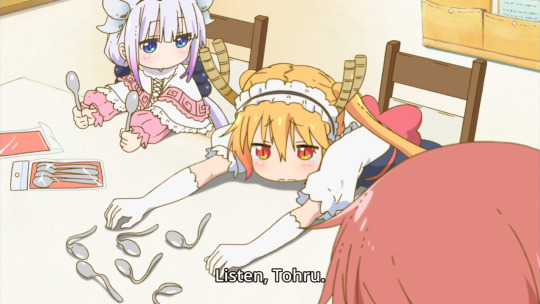
Lol that they bought spoons just to practice with despite being able to easily fix broken ones with magic anyway.

Yet another small nuance thing, but Kobayashi’s line leans more toward a sort of “it’s alright if you just do the things only you can do.” Again, minor and arguable, but it’s the difference between saying it’s okay to do something versus saying you should do something. (original: トールにしか出来ないことをすればいいんだよ)

Lunches in elementary school are eaten in the classroom, and typically served (as seen) by the students themselves; whoever’s on duty. The meals themselves are made by professionals, of course, and tend to be pretty healthy.

The “magic” she says here is actually the English word magic (majikku, rather), which in conversation is more likely to refer to magic tricks (similar to tejina above) than actual magic (which would generally be some variant of the Japanese word for it, mahou 魔法).

The stereotypical “hypnotism” item to swing in front of people in Japan is a 5 yen coin attached to string, rather than a watch. 5 yen coins have a hole in the middle, so it’s easy to tie a string to. Plus, they have a cultural connection to sort of supernatural stuff already; they’re a favorite for making donations at shrines and such because “five yen” (五円) is pronounced “go-en,” which is the same as a word for basically “fate” (ご縁).

Episode One Notes
Episode Two Notes
Episode Three Notes
Episode Four Notes
52 notes
·
View notes